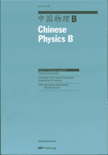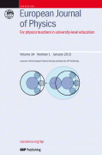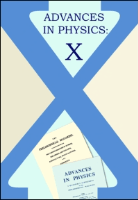
INDIAN JOURNAL OF PHYSICS
Scope & Guideline
Exploring Innovative Research in Physics
Introduction
Aims and Scopes
- Theoretical Physics:
Focuses on the development and application of mathematical models and frameworks to understand physical phenomena, including quantum mechanics, relativity, and statistical mechanics. - Condensed Matter Physics:
Explores the properties of solid and liquid matter, including phase transitions, superconductivity, magnetism, and nanostructures. - Optics and Photonics:
Investigates the behavior and properties of light, including optical materials, photonic devices, and laser technology. - Astrophysics and Cosmology:
Studies celestial phenomena and the universe's structure, including galaxy formation, cosmic microwave background radiation, and dark matter. - Plasma Physics:
Covers the behavior of ionized gases and their applications in fusion energy, astrophysical phenomena, and space science. - Nanotechnology and Materials Science:
Focuses on the synthesis, characterization, and application of materials at the nanoscale, including semiconductor devices and nanocomposites. - Biophysics and Medical Physics:
Explores the application of physics concepts and techniques to biological systems and medical technologies, including imaging and therapeutic methods. - Interdisciplinary Research:
Encourages collaborations across various scientific disciplines, integrating physics with chemistry, biology, and engineering to solve complex problems.
Trending and Emerging
- Quantum Computing and Information:
With the rapid advancement of quantum technologies, research related to quantum computing, quantum cryptography, and quantum entanglement has gained significant traction, showcasing its potential for revolutionizing information processing. - Renewable Energy Technologies:
Research on solar cells, energy storage systems, and alternative energy sources is trending due to global efforts to transition to sustainable energy practices, particularly in the development of perovskite solar cells and nanostructured materials. - Complex Systems and Nonlinear Dynamics:
An increasing interest in modeling complex systems, including biological and ecological systems, as well as the study of nonlinear dynamics, is evident in recent publications, reflecting the interdisciplinary nature of modern physics. - Biophysics and Medical Applications:
Research that bridges physics with biology and medicine, including medical imaging, therapeutic techniques, and biomaterials, is emerging as a significant area of interest, driven by advances in technology and healthcare needs. - Plasma Physics in Astrophysics:
The application of plasma physics to astrophysical phenomena, such as solar flares, cosmic rays, and the dynamics of stellar objects, is gaining momentum, highlighting the relevance of plasma physics in understanding the universe.
Declining or Waning
- Nuclear Physics:
While still vital, the focus on nuclear physics research, particularly experimental studies of nuclear reactions and decay processes, appears to have diminished compared to other areas, possibly due to funding shifts towards more applied or interdisciplinary research. - Classical Mechanics:
Research centered on traditional classical mechanics topics, such as rigid body dynamics and classical wave theory, has seen a decrease as newer fields like quantum mechanics and complex systems gain prominence. - Low-Energy Nuclear Reactions:
This area has become less prominent as experimental techniques and theoretical models evolve, leading to a shift towards higher-energy physics and astrophysical applications. - Material Science with Traditional Approaches:
Research focusing solely on classical material science without the integration of nanotechnology or advanced characterization methods is witnessing a decline, as the field moves towards more innovative and interdisciplinary approaches.
Similar Journals

Chinese Physics B
Bridging disciplines to enhance our understanding of the universe.Chinese Physics B, published by IOP Publishing Ltd, is a distinguished journal in the field of Physics and Astronomy, offering a platform for researchers to disseminate cutting-edge studies and advancements. With an ISSN of 1674-1056 and an E-ISSN of 2058-3834, this journal emphasizes open access, ensuring that groundbreaking research is readily available to a global audience. Reflecting its commitment to quality, Chinese Physics B is categorized in the Q3 quartile (2023) in its subject area and ranks 118 out of 243 among its peers in general physics and astronomy according to Scopus, placing it in the 51st percentile. Publishing since 2008, the journal not only maintains a rigorous peer-review process but also aims to foster collaboration among academics in various physics disciplines. With its base in the United Kingdom, Chinese Physics B remains a crucial resource for those seeking to stay abreast of developments in the diverse world of physics.

Lithuanian Journal of Physics
Connecting Scholars through Groundbreaking ResearchWelcome to the Lithuanian Journal of Physics, an esteemed publication helmed by the Lithuanian Physical Society, dedicated to advancing the field of physics and astronomy. Established in 2008 and continually publishing insightful research through 2024, this journal aims to provide a platform for high-quality scholarly articles that contribute to the understanding of various physical phenomena. With a steady presence in the academic landscape, the journal is currently ranked in the fourth quartile of the Physics and Astronomy category and is positioned at the 18th percentile in its Scopus ranking, reflecting its niche focus and accessibility for researchers and students alike. Although currently not operating under an open access model, the journal remains a vital resource for professionals seeking to stay informed on the latest developments in the field. The Lithuanian Journal of Physics invites contributions that inspire collaboration and innovation in physical sciences, making it an invaluable resource for the global scientific community seeking to expand knowledge within this dynamic field.

PHYSICAL REVIEW LETTERS
Advancing the Frontiers of Physics and AstronomyPhysical Review Letters, published by the American Physical Society, is a premier journal in the field of Physics and Astronomy renowned for its rapid dissemination of high-impact research findings. With a distinguished history dating back to 1958 and an impressive ranking of #13 out of 243 in the general physics category, it stands proudly within the Q1 quartile, placing it in the top 6% of journals in its field. The journal focuses on brief reports of significant fundamental research across all areas of physics, making it an essential resource for researchers, professionals, and students seeking to stay at the forefront of developments in their field. Although Physical Review Letters does not offer open access options, its rigorous peer-review process ensures a high standard of quality and relevance in its published articles. With an unwavering commitment to advancing the understanding of physical science, this journal is indispensable for those looking to make a genuine impact in their research endeavors.

Recent Contributions to Physics
Unlocking the latest breakthroughs in scientific research.Recent Contributions to Physics is a distinguished journal published by AL-FARABI KAZAKH NATIONAL UNIVERSITY, focusing on the latest developments and research breakthroughs in the field of physics. Established as an open access journal since 2008, it aims to facilitate the wide dissemination of knowledge by allowing researchers, professionals, and students worldwide to access high-quality content without barrier. Featuring a diverse range of topics within physics, from theoretical innovations to practical applications, this journal is an essential resource for anyone seeking to stay at the forefront of scientific advancement. Its commitment to quality and accessibility not only enhances the impact of research in the scientific community but also promotes collaboration across disciplines. With its dedication to fostering a vibrant academic dialogue, Recent Contributions to Physics is poised as a key contributor to the future of physics research.

Frontiers of Physics
Advancing the Boundaries of Physics ResearchFrontiers of Physics, published by Higher Education Press, is a premier open-access journal dedicated to fostering innovative research and excellence within the field of physics. With an ISSN of 2095-0462 and an E-ISSN of 2095-0470, this rapidly growing journal has established itself as a valuable platform for disseminating cutting-edge findings, covering a diverse range of topics from theoretical frameworks to experimental advancements. Notably, Frontiers of Physics has achieved an impressive Q1 ranking in the 2023 Scopus Quartiles for Physics and Astronomy, securing a competitive 5th out of 81 positions in its category, reflecting a high impact factor that underscores its importance to the scientific community. Since its inception in 2011 and continuing through 2024, the journal aims to bridge the gap between academia and industry, encouraging collaboration among researchers, professionals, and students alike. Its commitment to open access ensures that high-quality research is readily accessible, thereby promoting knowledge sharing and advancement in the global physics community. Explore the potential of your research in Frontiers of Physics, where the future of physics flourishes.

EUROPEAN JOURNAL OF PHYSICS
Fostering Dialogue in the World of PhysicsEuropean Journal of Physics, published by IOP Publishing Ltd, is a premier international journal serving the diverse field of physics and astronomy. With a commitment to advancing scientific knowledge since its inception in 1980, the journal provides a platform for original research articles, reviews, and topical discussions in various domains, including theoretical and experimental physics. Operating out of the United Kingdom, the journal has achieved a commendable Q2 ranking in the Physics and Astronomy (miscellaneous) category for 2023, reflecting its robust influence in the academic community, alongside a notable Scopus Rank that underscores its relevance in both the Social Sciences and General Physics and Astronomy fields. Although it does not currently offer open access, the journal's traditional publication model ensures rigorous peer review, maintaining high scholarly standards that are imperative for researchers, professionals, and students striving to stay ahead in their respective fields. Don't miss the opportunity to engage with cutting-edge research and contribute to the ongoing dialogue in physics by accessing this vital resource.

Science China-Physics Mechanics & Astronomy
Exploring the Frontiers of Mechanics and AstronomyScience China-Physics Mechanics & Astronomy, published by SCIENCE PRESS, stands as a prestigious journal within the Physics and Astronomy domain, particularly recognized for its contributions to the understanding of fundamental and applied physics. With an exhilarating Q1 ranking in the 2023 category and earning a remarkable scopus rank of #21 out of 243, the journal demonstrates its significant impact, being positioned in the 91st percentile of its field. Operating under an Open Access model, it facilitates the broad dissemination of high-quality research, ensuring accessibility for researchers, professionals, and students worldwide. Its scope covers a variety of essential topics in physics and astronomy, promoting a comprehensive understanding of the latest advancements from 2010 through 2024. The journal is a vital resource for anyone aiming to stay at the forefront of research in these dynamic fields, with its prominent address located in Beijing, China, symbolizing its global influence.

Advances in Physics-X
Empowering Knowledge through Open AccessAdvances in Physics-X is a premier open-access journal published by Taylor & Francis Ltd, dedicated to advancing the frontiers of knowledge in the field of Physics and Astronomy. Since its inception in 2016, the journal has established itself as a vital platform for researchers and professionals, showcasing innovative research and cutting-edge theories that influence a broad array of sub-disciplines within physics. With an impressive impact factor and ranked in the 94th percentile among its peers, it resides in the Q1 category for Physics and Astronomy (miscellaneous), indicating its significant contributions to the academic community. Located in the United Kingdom, the journal encourages open access to foster wider dissemination and visibility of scholarly works, aligning with contemporary academic trends that prioritize global knowledge sharing. The ongoing commitment to publishing high-quality research ensures that Advances in Physics-X remains an essential resource for students, industry experts, and academics alike, helping to shape the future of physics research through collaboration and innovation.

Physical Review Research
Advancing the frontiers of physics and astronomy.Physical Review Research, published by the American Physical Society, is a premier open access journal dedicated to the dissemination of high-quality research across all areas of physics and astronomy. Since its inception in 2019, this journal has quickly established itself as a vital platform for researchers, achieving a prestigious Q1 ranking in the dynamics of Physics and Astronomy (miscellaneous) and holding a commendable position in the Scopus Rankings with a rank of #29 out of 243, placing it in the 88th percentile. With the commitment to fostering scientific collaboration and transparency, Physical Review Research offers unrestricted access to valuable findings, enabling researchers, professionals, and students alike to engage with cutting-edge contributions in general physics and astronomy. As it converges into its forthcoming years of publication, the journal remains dedicated to showcasing rigorous research and innovative ideas that drive the field forward.

Romanian Journal of Physics
Fostering global collaboration in scientific inquiry.Welcome to the Romanian Journal of Physics, a distinguished platform dedicated to advancing the field of physics and astronomy since its inception. Published by EDITURA ACAD ROMANE, this journal plays a pivotal role in disseminating high-quality research from Romania and around the globe, with an impressive impact factor that reflects its rigorous academic standards. With a focus on a broad range of topics in general physics and astronomy, it proudly maintains a Q2 ranking in its category for 2023, positioning itself among the top journals in the field. The journal, which has been converging valuable research contributions from 2008 until 2024, is accessible to a wide audience of researchers, professionals, and students interested in the latest developments and discoveries in physics. While it operates under a traditional publication model without Open Access, its commitment to quality research ensures that the contributions featured in its pages resonate well within the scientific community. We invite you to explore the rich findings published in the Romanian Journal of Physics and to engage with the vital discussions shaping the future of physics.